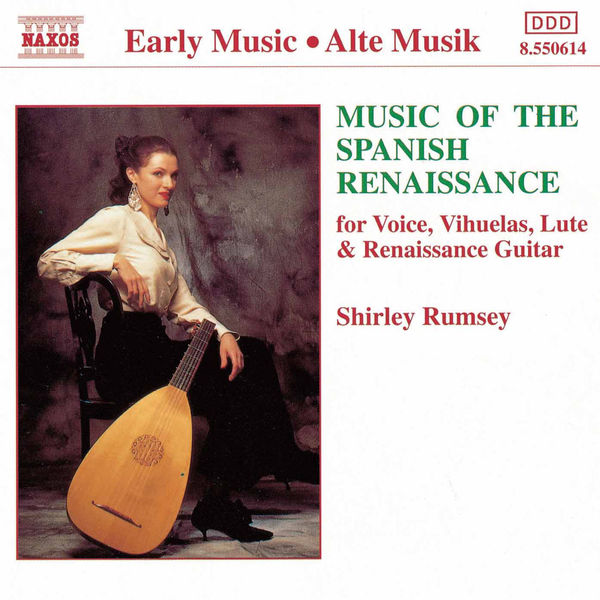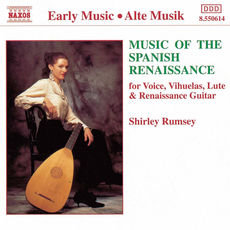
Unlimited Streaming
Listen to this album in high quality now on our apps
Start my trial period and start listening to this albumEnjoy this album on Qobuz apps with your subscription
SubscribeEnjoy this album on Qobuz apps with your subscription
Digital Download
Purchase and download this album in a wide variety of formats depending on your needs.
English lutenist and singer Shirley Rumsey earned high marks, both critically and artistically, for Music of the Italian Renaissance, her debut on Naxos. Rumsey's second go-round with Naxos was Music of the Spanish Renaissance, recorded in 1991. It pulls together some of the "hits" common during the second phase of the Iberian inquisition, a mixture of fantasias, instrumental dances, and songs. In the course of the album, Rumsey utilizes two different vihuelas, a lute, a Spanish guitar, and her voice.
Sprinkled throughout the program one will find such "usual suspect" Spanish lute and vihuela composers Luis Milán, Miguel de Fuenllana, and Alonzo Mudarra, but in no more relief than more obscure and intriguing figures such as Esteban Daza, a latecomer to this genre; enthusiastic amateur Diego Pisador; and the little-known, but eccentrically original Enriquez de Valderrábano. Anonymous pieces make up the rest, including several songs drawn from the Cançoner del duc de Calàbria and a couple of manuscript items found in the Archivo General de Simancas. The selection taken from the Cançoner is of added significance, as Spanish song in the mid-sixteenth century, with its emphasis on the vocal line, would have an impact upon the Italian Baroque to emerge five decades later. In the instrumental pieces, the melody line is often buried in the middle of the intabulations, and sometimes it is impossible to match the tune to the words, even though they often appear in red ink above the staff. By bringing the intabulated material into the same context as the vocal canciones, Rumsey draws a valuable parallel between the two.
Rumsey is an excellent lutenist, and her singing voice is pleasant, though very pure and "white." Rumsey's interpretation of this material is lacking in the sanguine and saucy aspects of Spanish Renaissance music. Nevertheless, this is not wholly Rumsey's fault; recorded at St. Andrew's in Toddington, the recording is a bit too distant and reverberant. What a disappointment it must be to learn how to roll a perfect "r," as Rumsey does in Fa-la-la-lan-le-ra, only to have it swallowed by the ambience of the room. As a general introduction to the music of this difficult to grasp end of the Western repertoire, Music of the Spanish Renaissance serves the purpose quite well, and the performances are enjoyable and solidly grounded, if not emotionally involving.
© TiVo
You are currently listening to samples.
Listen to over 100 million songs with an unlimited streaming plan.
From $17.49/month

Fa-la-la-lan-le-ra (Anonyme)
Shirley Rumsey
(C) 1993 Naxos (P) 1993 Naxos
Quien te hizo, Juan Pastor (version for lute) (Esteban Daza)
Shirley Rumsey - Esteban Daza, Composer
(C) 1993 Naxos (P) 1993 Naxos
Fantasia VIII (Luys de Narvaez)
Shirley Rumsey - Luys de Narvaez, Composer
(C) 1993 Naxos (P) 1993 Naxos
Yo me soy la morenica (Anonyme)
Shirley Rumsey
(C) 1993 Naxos (P) 1993 Naxos
Soy serranica (Anonyme)
Shirley Rumsey
(C) 1993 Naxos (P) 1993 Naxos
Guardame las vacas (Anonyme)
Shirley Rumsey
(C) 1993 Naxos (P) 1993 Naxos
De Antequera sale el moro (Miguel de Fuenllana)
Shirley Rumsey - Miguel de Fuenllana, Composer
(C) 1993 Naxos (P) 1993 Naxos
Libro de musica de vihuela de mano intitulado El maestro: Fantasia No. 1 (Luys Milan)
Shirley Rumsey - Luys Milan, Composer
(C) 1993 Naxos (P) 1993 Naxos
Libro de musica de vihuela de mano intitulado El maestro: Fantasia No. 2 (Luys Milan)
Shirley Rumsey - Luys Milan, Composer
(C) 1993 Naxos (P) 1993 Naxos
Ay luna que reluzes (Anonyme)
Shirley Rumsey
(C) 1993 Naxos (P) 1993 Naxos
Duo de Josquin (Miguel de Fuenllana)
Shirley Rumsey - Miguel de Fuenllana, Composer
(C) 1993 Naxos (P) 1993 Naxos
Pavanilla [Manuscrito de Simancas, ca. 1560] (Anonyme)
Shirley Rumsey
(C) 1993 Naxos (P) 1993 Naxos
La moreda [Manuscrito de Simancas, ca. 1560] (Anonyme)
Shirley Rumsey
(C) 1993 Naxos (P) 1993 Naxos
Vos me matastes (Miguel de Fuenllana)
Shirley Rumsey - Miguel de Fuenllana, Composer
(C) 1993 Naxos (P) 1993 Naxos
Fantaisie No. 8 (Luys Milan)
Shirley Rumsey - Luys Milan, Composer
(C) 1993 Naxos (P) 1993 Naxos
La mananna de San Juan (Diego Pisador)
Shirley Rumsey - Diego Pisador, Composer
(C) 1993 Naxos (P) 1993 Naxos
Morenica, dame un beso (Miguel de Fuenllana)
Shirley Rumsey - Miguel de Fuenllana, Composer
(C) 1993 Naxos (P) 1993 Naxos
Conde Claros (Anonyme)
Shirley Rumsey
(C) 1993 Naxos (P) 1993 Naxos
Gritos dava la morenica so el olivar (Esteban Daza)
Shirley Rumsey - Esteban Daza, Composer
(C) 1993 Naxos (P) 1993 Naxos
Con que la lavare (Miguel de Fuenllana)
Shirley Rumsey - Miguel de Fuenllana, Composer
(C) 1993 Naxos (P) 1993 Naxos
Tiento (Alonso de Mudarra)
Shirley Rumsey - Alonso Mudarra, Composer
(C) 1993 Naxos (P) 1993 Naxos
Soneto I (Enriquez de Valderrábano)
Shirley Rumsey - Enriquez de Valderrábano, Composer
(C) 1993 Naxos (P) 1993 Naxos
Soneto II (Enriquez de Valderrábano)
Shirley Rumsey - Enriquez de Valderrábano, Composer
(C) 1993 Naxos (P) 1993 Naxos
Si la noche laze escura (Diego Pisador)
Shirley Rumsey - Diego Pisador, Composer
(C) 1993 Naxos (P) 1993 Naxos
Album review
English lutenist and singer Shirley Rumsey earned high marks, both critically and artistically, for Music of the Italian Renaissance, her debut on Naxos. Rumsey's second go-round with Naxos was Music of the Spanish Renaissance, recorded in 1991. It pulls together some of the "hits" common during the second phase of the Iberian inquisition, a mixture of fantasias, instrumental dances, and songs. In the course of the album, Rumsey utilizes two different vihuelas, a lute, a Spanish guitar, and her voice.
Sprinkled throughout the program one will find such "usual suspect" Spanish lute and vihuela composers Luis Milán, Miguel de Fuenllana, and Alonzo Mudarra, but in no more relief than more obscure and intriguing figures such as Esteban Daza, a latecomer to this genre; enthusiastic amateur Diego Pisador; and the little-known, but eccentrically original Enriquez de Valderrábano. Anonymous pieces make up the rest, including several songs drawn from the Cançoner del duc de Calàbria and a couple of manuscript items found in the Archivo General de Simancas. The selection taken from the Cançoner is of added significance, as Spanish song in the mid-sixteenth century, with its emphasis on the vocal line, would have an impact upon the Italian Baroque to emerge five decades later. In the instrumental pieces, the melody line is often buried in the middle of the intabulations, and sometimes it is impossible to match the tune to the words, even though they often appear in red ink above the staff. By bringing the intabulated material into the same context as the vocal canciones, Rumsey draws a valuable parallel between the two.
Rumsey is an excellent lutenist, and her singing voice is pleasant, though very pure and "white." Rumsey's interpretation of this material is lacking in the sanguine and saucy aspects of Spanish Renaissance music. Nevertheless, this is not wholly Rumsey's fault; recorded at St. Andrew's in Toddington, the recording is a bit too distant and reverberant. What a disappointment it must be to learn how to roll a perfect "r," as Rumsey does in Fa-la-la-lan-le-ra, only to have it swallowed by the ambience of the room. As a general introduction to the music of this difficult to grasp end of the Western repertoire, Music of the Spanish Renaissance serves the purpose quite well, and the performances are enjoyable and solidly grounded, if not emotionally involving.
© TiVo
About the album
- 1 disc(s) - 24 track(s)
- Total length: 00:54:34
- 1 Digital booklet
- Main artists: Shirley Rumsey
- Composer: Enriquez de Valderrábano
- Label: Naxos
- Genre: Classical
(C) 1993 Naxos (P) 1993 Naxos
Improve album information
 Why buy on Qobuz...
Why buy on Qobuz...
-
Stream or download your music
Buy an album or an individual track. Or listen to our entire catalogue with our high-quality unlimited streaming subscriptions.
-
Zero DRM
The downloaded files belong to you, without any usage limit. You can download them as many times as you like.
-
Choose the format best suited for you
Download your purchases in a wide variety of formats (FLAC, ALAC, WAV, AIFF...) depending on your needs.
-
Listen to your purchases on our apps
Download the Qobuz apps for smartphones, tablets and computers, and listen to your purchases wherever you go.



